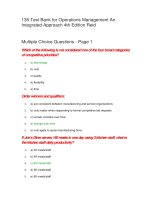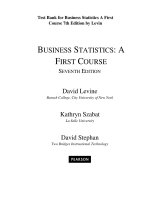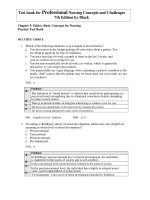Download test bank for human physiology an integrated approach 7th edition by silverthorn
Bạn đang xem bản rút gọn của tài liệu. Xem và tải ngay bản đầy đủ của tài liệu tại đây (438.41 KB, 113 trang )
Test Bank for Human Physiology An
Integrated Approach 7th Edition by
Silverthorn
Link download full:
/>
Chapter 8 Neurons: Cellular and Network Properties
1) The portions of a neuron that extend off of the roughly spherical cell body are
usually collectively called
A) protrusions.
2. B) processes.
3. C) prostheses.
4. D) projections.
Answer: B
Section: Cells of the Nervous System
Learning Outcome: 8.2
Bloom’s Taxonomy: Knowledge
2) Detailed understanding of the cellular basis of signaling in the nervous system
has led to good understanding of consciousness, intelligence, and emotion.
A) True
B) False
Answer: B
Section: Organization of the Nervous System Learning Outcome: 8.1
Bloom’s Taxonomy: Knowledge
3) Neurotransmitter is stored and released from
A) axon terminals only.
B) axon varicosities only.
C) dendritic spines only.
D) cell bodies only.
E) axon terminals and axon varicosities.
Answer: E
Section: Cells of the Nervous System
Learning Outcome: 8.2
Bloom’s Taxonomy: Knowledge
4) Information coming into the central nervous system is transmitted along
________ neurons.
A) afferent
B) sensory
C) efferent
D) afferent and sensory
E) sensory and efferent
Answer: D
Section: Organization of the Nervous System
Learning Outcome: 8.1
Bloom’s Taxonomy: Knowledge
5) The afferent and efferent axons together form the
A) central nervous system.
B) autonomic division system.
C) somatic motor division of the nervous system.
D) peripheral nervous system.
E) visceral nervous system.
Answer: D
Section: Organization of the Nervous System
Learning Outcome: 8.1
Bloom’s Taxonomy: Knowledge
6) The brain and spinal cord together compose the
A) central nervous system.
B) autonomic division system.
C) somatic motor division of the nervous system.
D) peripheral nervous system.
E) visceral nervous system.
Answer: A
Section: Organization of the Nervous System
Learning Outcome: 8.1
Bloom’s Taxonomy: Knowledge
7) Exocrine glands, smooth muscles, and cardiac muscles are controlled by the
A) central nervous system.
B) autonomic nervous system.
C) somatic motor division.
D) peripheral nervous system.
E) enteric nervous system.
Answer: B
Section: Organization of the Nervous System
Learning Outcome: 8.1 Bloom’s Taxonomy: Knowledge
8) Autonomic motor neurons are subdivided into the
A) visceral and somatic divisions.
B) sympathetic and parasympathetic divisions.
C) central and peripheral divisions.
D) visceral and enteric divisions.
E) somatic and enteric divisions.
Answer: B
Section: Organization of the Nervous System
Learning Outcome: 8.1
Bloom’s Taxonomy: Knowledge
9) The enteric nervous system is a network of neurons that function in controlling
A) reproduction.
B) digestion.
C) excretion, particularly urination.
D) the skeletal system.
E) the endocrine system.
Answer: B
Section: Organization of the Nervous System
Learning Outcome: 8.1
Bloom’s Taxonomy: Knowledge
10) In general, the nervous system is composed of which two types of cells?
1. motor
2. neurons
3. sensory
4. glial
5. associative
6. A) 1 and 2
7. B) 1 and 3
8. C) 2 and 4
9. D) 3 and 4
10. E) 3 and 5
Answer: C
Section: Cells of the Nervous System
Learning Outcome: 8.1
Bloom’s Taxonomy: Knowledge
11) The cell body of neurons is generally
1. A) 90% of the cell volume.
2. B) 50% of the cell volume.
3. C) 10% of the cell volume.
4. D) found in the same position on every neuron.
Answer: C
Section: Cells of the Nervous System
Learning Outcome: 8.2
Bloom’s Taxonomy: Knowledge
12) Interneurons are found
1. A) only in the brain.
2. B) only in the spinal cord.
3. C) only in the CNS.
4. D) throughout the nervous system.
5. E) only in spinal nerves.
Answer: C
Section: Cells of the Nervous System Learning Outcome: 8.1
Bloom’s Taxonomy: Knowledge
13) The multiple thin, branched structures on a neuron whose main function is to
receive
incoming signals are the
1. A) cell bodies.
2. B) axons.
3. C) dendrites.
4. D) somata.
5. E) None of the answers are correct.
Answer: C
Section: Cells of the Nervous System
Learning Outcome: 8.3
Bloom’s Taxonomy: Knowledge
14) The collection of axons that carries information between the central nervous
system and the
peripheral effectors is called the
1. A) axon hillock.
2. B) varicosity.
3. C) axon.
4. D) dendrite.
5. E) nerve.
Answer: E
Section: Cells of the Nervous System
Learning Outcome: 8.2
Bloom’s Taxonomy: Knowledge
15) The region where the axon terminal meets its target cell is called the
1. A) collateral.
2. B) hillock. 3. C) synapse.
4. D) nerve.
5. E) dendrites.
Answer: C
Section: Cells of the Nervous System
Learning Outcome: 8.3
Bloom’s Taxonomy: Knowledge
16) The axon is connected to the cell body by the
1. A) myelin sheath.
2. B) axon terminal.
3. C) collaterals.
4. D) axon hillock.
5. E) synapse.
Answer: D
Section: Cells of the Nervous System
Learning Outcome: 8.2
Bloom’s Taxonomy: Knowledge
17) Branches that sometimes occur along the length of an axon are called
1. A) dendrites.
2. B) axon terminals.
3. C) collaterals.
4. D) axon hillocks.
5. E) synapses.
Answer: C
Section: Cells of the Nervous System
Learning Outcome: 8.2 Bloom’s Taxonomy: Knowledge
18) Neurotransmitters are released from the
1. A) dendrites.
2. B) axon terminals.
3. C) collaterals.
4. D) axon hillock.
5. E) synapse.
Answer: B
Section: Cells of the Nervous System
Learning Outcome: 8.3
Bloom’s Taxonomy: Knowledge
19) The term axonal transport refers to
1. A) the release of neurotransmitter molecules from the axon.
2. B) the transport of microtubules to the axon for structural support.
3. C) vesicle transport of proteins and organelles down the axon.
4. D) the movement of the axon terminal to synapse with a new postsynaptic cell.
5. E) None of the answers are correct.
Answer: C
Section: Cells of the Nervous System
Learning Outcome: 8.2
Bloom’s Taxonomy: Knowledge
20) Anterograde and retrograde axonal transport are forms of ________ transport.
1. A) fast
2. B) slow
3. C) Neither of these. Answer: A
Section: Cells of the Nervous System
Learning Outcome: 8.2
Bloom’s Taxonomy: Knowledge
21) Clusters of nerve cell bodies in the peripheral nervous system are called
1. A) microglia.
2. B) neuroglia.
3. C) glia.
4. D) ganglia.
5. E) nodes.
Answer: D
Section: Organization of the Nervous System
Learning Outcome: 8.1
Bloom’s Taxonomy: Knowledge
22) Glial cells
1. A) only provide structural and metabolic support.
2. B) only guide neurons during growth and repair.
3. C) only help maintain homeostasis of the brain’s extracellular fluid.
4. D) provide structural and metabolic support and help maintain homeostasis of
the brain’s extracellular fluid.
5. E) All of the answers are correct.
Answer: E
Section: Cells of the Nervous System
Learning Outcome: 8.4
Bloom’s Taxonomy: Knowledge
23) Glial cells communicate primarily using
1. A) electrical signals only.
2. B) chemical signals only.
3. C) neurotransmitters only.
4. D) neuromodulators only.
5. E) electrical signals and chemical signals.
Answer: B
Section: Cells of the Nervous System
Learning Outcome: 8.4
Bloom’s Taxonomy: Knowledge
24) Myelin is formed by
1. A) axons only.
2. B) Schwann cells only.
3. C) oligodendrocytes only.
4. D) Schwann cells and oligodendrocytes.
Answer: D
Section: Cells of the Nervous System
Learning Outcome: 8.4
Bloom’s Taxonomy: Knowledge
25) These glial cells act as scavengers.
1. A) Schwann cells
2. B) astrocytes
3. C) microglia
4. D) oligodendrocytes
5. E) ependymal cells
Answer: C Section: Cells of the Nervous System
Learning Outcome: 8.4
Bloom’s Taxonomy: Knowledge
26) These glial cells may contribute to Lou Gehrig’s disease.
1. A) Schwann cells
2. B) astrocytes
3. C) microglia
4. D) oligodendrocytes
5. E) ependymal cells
Answer: C
Section: Cells of the Nervous System
Learning Outcome: 8.4
Bloom’s Taxonomy: Knowledge
27) The Nernst equation predicts
1. A) intracellular ion concentrations.
2. B) extracellular ion concentrations.
3. C) the membrane potential resulting from all permeable ions.
4. D) the membrane potential resulting from permeability to a single ion.
5. E) the threshold membrane potential.
Answer: D
Section: Electrical Signals in Neurons
Learning Outcome: 8.5
Bloom’s Taxonomy: Comprehension
28) Which is the correctly written Nernst equation?
1. A) 61/z × log [ion]out/ [ion]in
2. B) 61/z × log [ion]in/ [ion]out 3. C) log 61/z × [ion]in/ [ion]out
4. D) log 61/z × [ion]out/ [ion]in
Answer: A
Section: Electrical Signals in Neurons
Learning Outcome: 8.5
Bloom’s Taxonomy: Comprehension
29) What does the Goldman-Hodgkin-Katz equation take into account that the
Nernst equation does NOT?
1. A) the electrical charges of the ions
2. B) the permeabilities of the ions
3. C) the solubilities of the ions
4. D) the sizes of the ions
5. E) the temperature
Answer: B
Section: Electrical Signals in Neurons
Learning Outcome: 8.5
Bloom’s Taxonomy: Knowledge
30) The resting membrane potential results from
1. A) uneven distribution of ions across the cell membrane only.
2. B) differences in membrane permeability to Na+and K+
3. C) activity of the sodium/potassium pump only.
4. D) uneven distribution of ions across the cell membrane and differences in
membrane permeability to Na+and K+.
5. E) None of the answers are correct.
Answer: D
Section: Electrical Signals in Neurons
Learning Outcome: 8.5 Bloom’s Taxonomy: Knowledge
31) Which ion(s) is/are higher in concentration inside the cell compared to outside?
1. A) potassium
2. B) sodium
3. C) chloride
4. D) calcium
5. E) More than one of the answers is correct.
Answer: A
Section: Electrical Signals in Neurons
Learning Outcome: 8.5
Bloom’s Taxonomy: Knowledge
32) The channelopathy known as QT syndrome is a result of mutation in ________
channels.
1. A) sodium
2. B) potassium
3. C) calcium
4. D) chloride
5. E) sodium, potassium, or calcium Answer: E
Section: Electrical Signals in Neurons
Learning Outcome: 8.6
Bloom’s Taxonomy: Knowledge
33) Ion channel inactivation is
1. A) closing of the channel in response to decrease in the stimulus.
2. B) closing of the channel even when the stimulus continues. 3. C) any type of
channel closing.
4. D) None of the answers are correct. Answer:
B
Section: Electrical Signals in Neurons
Learning Outcome: 8.8
Bloom’s Taxonomy: Knowledge
34) The total amount of neurotransmitter released at the axon terminal is directly
related to
1. A) the amplitude of the action potential.
2. B) the length of the axon.
3. C) the total number of action potentials.
4. D) the amplitude of the graded potential.
Answer: C
Section: Cell-to-Cell Communication in the Nervous System
Learning Outcome: 8.11
Bloom’s Taxonomy: Comprehension
35) Which of the following is the most common location where action potentials
originate?
1. A) dendrites
2. B) cell body
3. C) axon hillock
4. D) synaptic cleft
5. E) synaptic bouton
Answer: C
Section: Cells of the Nervous System
Learning Outcome: 8.2
Bloom’s Taxonomy: Knowledge
36) The rising phase of the action potential is due to
1. A) Na+flow into the cell only.
2. B) Na+flow out of the cell only.
3. C) K+flow out of the cell only.
4. D) K+flow into the cell only.
5. E) Na+flow out of the cell and K+flow into the cell.
Answer: A
Section: Electrical Signals in Neurons
Learning Outcome: 8.8
Bloom’s Taxonomy: Knowledge
37) The falling phase of the action potential is due primarily to
1. A) Na+flow in the cell only.
2. B) Na+flow out of the cell only.
3. C) K+flow out of the cell only.
4. D) K+flow into the cell only.
5. E) Na+flow out of the cell and K+flow into the cell.
Answer: C
Section: Electrical Signals in Neurons
Learning Outcome: 8.8
Bloom’s Taxonomy: Knowledge
38) The point during an action potential when the inside of the cell has become
more positive
than the outside is known as the
1. A) depolarization.
2. B) rising phase.
3. C) falling phase.
4. D) overshoot.
5. E) peak.
Answer: D Section: Electrical Signals in Neurons
Learning Outcome: 8.8
Bloom’s Taxonomy: Knowledge
39) Choose all of the items that are incorrectly matched.
1. A) inactivation gate — closed at rest
2. B) activation gate — open at rest
3. C) inactivation gate — closed during repolarization
4. D) activation gate — opens during depolarization
5. E) All of the answers are incorrectly matched.
Answer: D
Section: Electrical Signals in Neurons
Learning Outcome: 8.8
Bloom’s Taxonomy: Knowledge
40) The absolute refractory period of an action potential
1. A) only ensures one-way travel down an axon.
2. B) only allows a neuron to ignore a second signal sent that closely follows the
first.
3. C) only prevents summation of action potentials.
4. D) ensures one-way travel down an axon and allows a neuron to ignore a
second signal sent that closely follows the first.
5. E) ensures one-way travel down an axon, allows a neuron to ignore a second
signal sent that closely follows the first, and prevents summation of action
potentials.
Answer: E
Section: Electrical Signals in Neurons
Learning Outcome: 8.9
Bloom’s Taxonomy: Comprehension
41) In order to signal a stronger stimulus, action potentials become
1. A) higher in amplitude only.
2. B) more frequent only.
3. C) longer-lasting only.
4. D) higher in amplitude and more frequent.
5. E) higher in amplitude and longer-lasting.
Answer: B
Section: Electrical Signals in Neurons
Learning Outcome: 8.8
Bloom’s Taxonomy: Comprehension
42) All of the following must occur before a second action potential can begin,
EXCEPT
1. A) the Na+and K+ions that moved in/out of the cell must move back to their
original compartments.
2. B) the Na+inactivation gate must open and the Na+activation gate must close.
3. C) the absolute refractory period must occur.
4. D) the Na+and K+ions that moved in/out of the cell must move back to their
original
compartments; the Na+ inactivation gate must open; and the Na+ activation gate
must close.
5. E) None of the answers are correct.
Answer: A
Section: Electrical Signals in Neurons
Learning Outcome: 8.9
Bloom’s Taxonomy: Comprehension
43) Voltage-regulated channels are located
1. A) within the cytosol only.
2. B) in the membranes of dendrites only.
3. C) in the membranes of axons only.
4. D) on the neuron cell body only.
5. E) in the membranes of dendrites, in the membranes of axons, and on the
neuron cell body. Answer: E
Section: Electrical Signals in Neurons
Learning Outcome: 8.8
Bloom’s Taxonomy: Knowledge
44) The sodium-potassium exchange pump
1. A) must re-establish ion concentrations after each action potential.
2. B) transports sodium ions into the cell during depolarization.
3. C) transports potassium ions out of the cell during repolarization.
4. D) moves sodium and potassium in the direction of their chemical gradients.
5. E) requires ATP to function.
Answer: E
Section: Electrical Signals in Neurons
Learning Outcome: 8.8
Bloom’s Taxonomy: Comprehension
45) The all-or-none principle states that
1. A) all stimuli will produce identical action potentials.
2. B) all stimuli great enough to bring the membrane to threshold will produce
action potentials of identical magnitude.
3. C) the greater the magnitude of the stimuli, the greater the intensity of the
action potential.
4. D) only sensory stimuli can activate action potentials.
5. E) only motor stimuli can activate action potentials.
Answer: B
Section: Electrical Signals in Neurons
Learning Outcome: 8.8
Bloom’s Taxonomy: Knowledge 46) When voltage-gated Na+ channels of a
resting neuron open,
1. A) Na+enters the neuron.
2. B) Na+leaves the neuron.
3. C) the neuron depolarizes.
4. D) Na+enters the neuron and the neuron depolarizes.
5. E) Na+leaves the neuron and the neuron depolarizes.
Answer: D
Section: Electrical Signals in Neurons
Learning Outcome: 8.8
Bloom’s Taxonomy: Knowledge
47) When voltage-gated K+ channels of a resting neuron open,
1. A) K+enters the neuron.
2. B) K+leaves the neuron.
3. C) the neuron depolarizes.
4. D) K+enters the neuron and the neuron depolarizes.
5. E) K+leaves the neuron and the neuron depolarizes.
Answer: B
Section: Electrical Signals in Neurons
Learning Outcome: 8.8
Bloom’s Taxonomy: Knowledge
48) In the membrane of a resting nerve cell, when chemically gated Cl- channels
open,
1. A) Cl- ions enter the cell.
2. B) Cl- ions leave the cell.
3. C) the cell becomes depolarized.
4. D) Cl- ions enter the cell and the cell becomes depolarized.
5. E) Cl- ions leave the cell and the cell becomes depolarized.
Answer: A Section: Electrical Signals in Neurons
Learning Outcome: 8.8
Bloom’s Taxonomy: Comprehension
49) Ion concentrations are first significantly affected after ________ action
potential(s).
1. A) one
2. B) a few dozen
3. C) a few hundred
4. D) a few thousand
5. E) a few million
Answer: D
Section: Electrical Signals in Neurons
Learning Outcome: 8.8
Bloom’s Taxonomy: Comprehension
50) Action potentials are primarily associated with the membranes of
1. A) dendrites only.
2. B) cell bodies only.
3. C) axons only.
4. D) dendrites and axons.
5. E) cell bodies and axons.
Answer: C
Section: Electrical Signals in Neurons
Learning Outcome: 8.8
Bloom’s Taxonomy: Knowledge
51) Which of the following will best increase the conduction rate of action
potentials?
1. A) Increase the diameter of the axon, decrease the resistance of the axon
membrane to ion
leakage. 2. B) Increase the diameter of the axon, increase the resistance of the
axon membrane to ion
leakage.
3.
C) Decrease the diameter of the axon, decrease the resistance of the
axon membrane to ion leakage.
4.
D) Decrease the diameter of the axon, increase the resistance of the
axon membrane to ion leakage.
Answer: B









